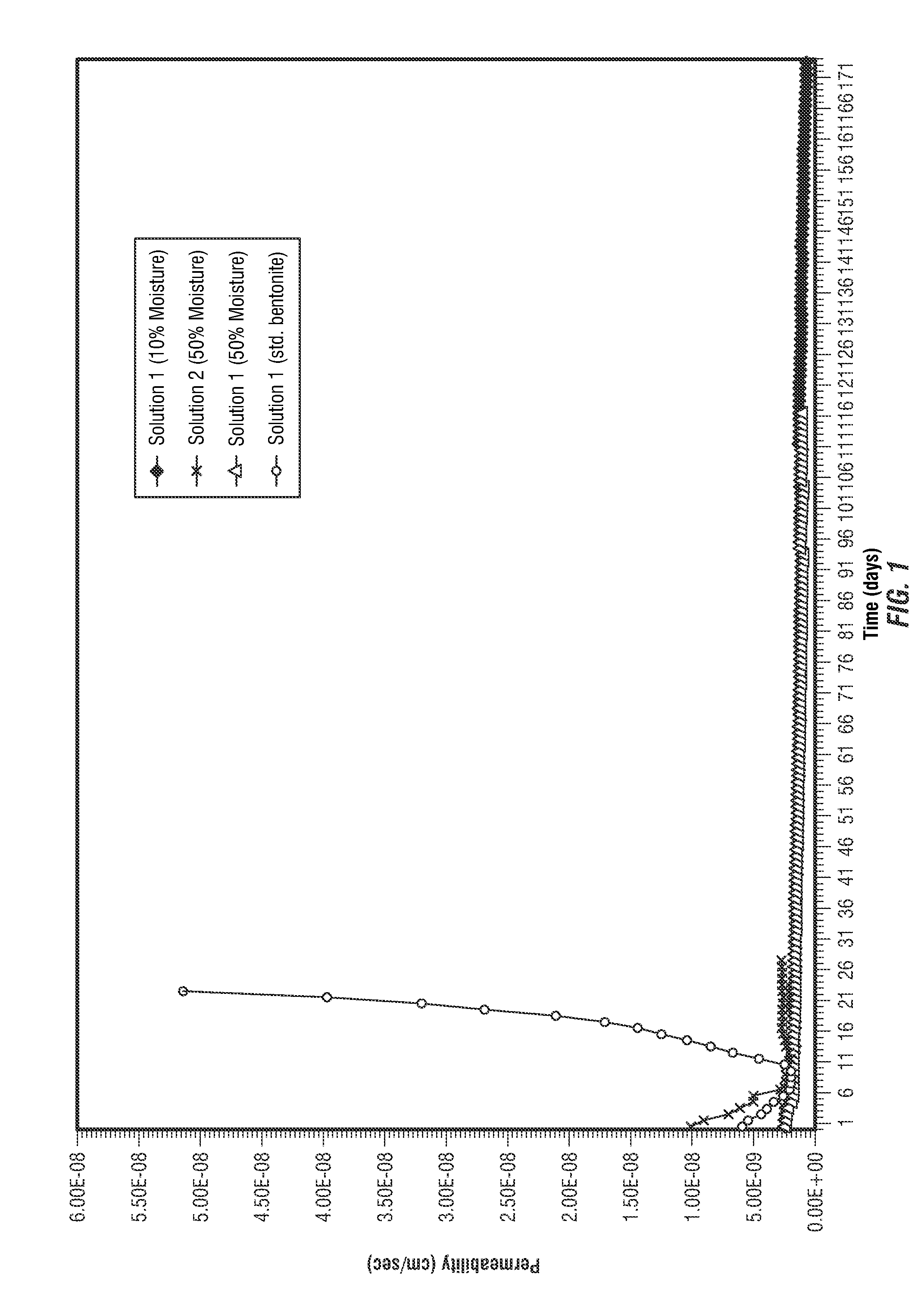Methods of using improved bentonite barrier compositions and related geosynthetic clay liners
a technology of bentonite and composition, applied in the direction of protective foundations, bulkheads/piles, foundation engineering, etc., can solve the problems of adversely affecting the absorbency of bentonite, and achieve the effect of enhancing low permeability
- Summary
- Abstract
- Description
- Claims
- Application Information
AI Technical Summary
Benefits of technology
Problems solved by technology
Method used
Image
Examples
example 1
[0059]In order to demonstrate the effectiveness of geosynthetic clay liner of the present invention, permeability parameters of geosynthetic clay liners were measured in solutions comprising complex electrolyte chemistries over time. Acid mine leachate, a synthetic leachate (Solution 1 as described in Table 2), and fly-ash leachate, an in situ leachate taken from real world depository (Solution 2 as described in Table 2) samples were analyzed by a third party independent lab. The composition of these leachates are given in Table 2 below. The testing of the liners was performed with these leachates. Additionally, different initial moisture contents of the bentonite in the bentonite barrier composition in the liner were tested to determine the effect of the initial moisture content on the retained permeability observed with the varying solution chemistries at a confining stress of 5.0 psi.
TABLE 2Liquid Analysis with High Ionic StrengthAcid MineFly-AshDrainageLeachate(Synthetic)(Real W...
example 2
[0066]The goal of this test was to explore the permeability of an unamended bentonite composition, i.e., one that does not contain a polyanionic low molecular weight polymer according to the present invention, without a liner. The ASTM D6766 standard protocol per GRI-GCL3 was used at a confining stress of 5.0 psi. The synthetic brine in the experiment contained 0.1N (or approximately 12,000 mg / L) CaCl2.
[0067]FIG. 2 shows that a sharp increase in permeability was observed after approximately 220 hours (˜9 days) in the synthetic brine. Thus, the data in FIG. 2 confirms the lack of retained permeability of a standard unamended bentonite in electrolyte conditions as shown in FIG. 1 within a reasonable margin of error.
example 3
[0068]In this example, ASTM D5084 protocol was used to evaluate the retained permeability of certain bentonite barrier compositions comprising approximately 99% bentonite and approximately 1% polyanionic cellulose (not incorporated within a geosynthetic clay liner) of the present invention in fly-ash leachate (Solution 2 in Table 2). This is referred to as amended bentonite in Table 3. This experiment involved measuring the permeability of the bentonite barrier composition sample in a leachate solution at a confining stress of 5.0 psi. The permeability was measured after 11 days of being in contact with the leachate solution. The result of the experiment is summarized in Table 3 below.
[0069]Table 3 shows that the bentonite barrier composition displayed a retained permeability of approximately 6×10−10 cm / s, which indicates that the bentonite barrier composition of the present invention is able to maintain an enhanced retained permeability. Thus, this Example suggests that the bentoni...
PUM
| Property | Measurement | Unit |
|---|---|---|
| Fraction | aaaaa | aaaaa |
| Speed | aaaaa | aaaaa |
| Speed | aaaaa | aaaaa |
Abstract
Description
Claims
Application Information
 Login to View More
Login to View More - R&D
- Intellectual Property
- Life Sciences
- Materials
- Tech Scout
- Unparalleled Data Quality
- Higher Quality Content
- 60% Fewer Hallucinations
Browse by: Latest US Patents, China's latest patents, Technical Efficacy Thesaurus, Application Domain, Technology Topic, Popular Technical Reports.
© 2025 PatSnap. All rights reserved.Legal|Privacy policy|Modern Slavery Act Transparency Statement|Sitemap|About US| Contact US: help@patsnap.com



